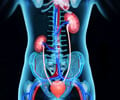Administration of Eculizumab can thwart kidney failure induced by Shiga toxin and holds promise as a therapeutic option for Hemolytic Uremic Syndrome.

Shiga toxin targets the podocyte causing Haemolytic Uraemic Syndrome through endothelial complement activation
Go to source). This, in turn, triggers a communication with nearby blood vessels, culminating in the formation of small blood clots. The underlying mechanism involves the activation of the 'complement' pathway and has the potential to result in the eventual decline of kidney function. The University of Bristol-led breakthrough is published in Med.
What is Hemolytic Uremic Syndrome?
The commonest cause of kidney failure in children is due to toxin producing bacteria that enters the circulation through the gut resulting in a disease called Hemolytic Uremic Syndrome (HUS). There are different types of HUS – the most common is called Shiga toxin-associated hemolytic uremic syndrome (STEC-HUS). As one of the most common causes of kidney problems in people of all ages, it can be particularly devastating in young children, often requiring kidney dialysis, with around one in 20 children developing life-long kidney failure or dying.‘A potential remedy for Hemolytic Uremic Syndrome, which stands as the primary cause of kidney failure in children necessitating dialysis, has been identified. #dialysis #kidneyhealth #kidneyfailure’





STEC-HUS commonly happens after a gut infection, associated with bloody diarrhoea. Exactly why the kidney is so susceptible to injury in STEC-HUS has until now, remained unclear. The research, funded by the Medical Research Council and Kidney Research UK and led by scientists from Bristol Renal, wanted to identify the mechanism underpinning the disease pathway. Critically, the team demonstrated in both mouse models and in human kidney cells that STEC-HUS can be successfully treated by inhibiting the complement pathway early in the disease process with a drug called Eculizumab.
Richard Coward, Professor of Renal Medicine at the University of Bristol and Consultant Pediatric Nephrologist at Bristol Royal hospital for Sick Children, and one of the study’s lead authors said: “As a children’s kidney doctor one of the most difficult and devastating diseases we treat is STEC-HUS, which causes kidney failure and death in some children. This is normally caused by a bacteria that enters the circulation via the gut causing bloody diarrhea.
Dr. Aisling McMahon, Executive director of research and policy at Kidney Research UK added: “This research has not only shown exactly how Shiga toxin is able to target the kidney and cause such devastating damage but has also discovered a way in which HUS could be stopped in its tracks using a drug that is already in clinical use. This is another great example of the importance of research in identifying new treatment options for patients, and we look forward to the next steps in this project.”
The research team has demonstrated that early use of Eculizumab can prevent Shiga-toxin driven kidney failure and the drug has therapeutic potential for this devastating disease that can result in life-long dialysis, and death, for some children.
Advertisement
The international team included researchers from Bristol Renal at the University of Bristol; Bristol Royal Hospital for Sick Children, UK; Hospital for Sick Children in Toronto, Canada; MRC Harwell Institute, Oxfordshire, UK; University of Manchester, UK; School of Medicine at Cardiff University, UK and Arkana Laboratories in Arizona, USA.
Advertisement
- Shiga toxin targets the podocyte causing Haemolytic Uraemic Syndrome through endothelial complement activation - (https://linkinghub.elsevier.com/retrieve/pii/S2666634023002891)
Source-Eurekalert















